Papers by Carol Schweiger
The purpose of the report is to describe the results of tasks and subtasks related to assisting w... more The purpose of the report is to describe the results of tasks and subtasks related to assisting with transit fare payment review and recommendations, and computer-aided dispatch (CAD)/automatic vehicle location (AVL) system review and recommendations. These tasks are part of a technology initiative project supported by the Maine State Transit Plan, which identified the need for effective targeted technology to improve rural transit demand and accessibility. The report includes assessments, implementation and expansion recommendations, and best practices and technology identification for both automated fare payment (AFP) and CAD/AVL systems.
Trafficinfratech, 2024
This article examines if the MaaS is still alive. According to the author, while the “success” of... more This article examines if the MaaS is still alive. According to the author, while the “success” of MaaS is questionable, it still appears to have strong backing by the governmental entities across the world, such as the city and regional governments and public transport agencies.
Trafficinfratech, 2024
This article examines if the MaaS is still alive. According to the author, while the “success” of... more This article examines if the MaaS is still alive. According to the author, while the “success” of MaaS is questionable, it still appears to have strong backing by the governmental entities across the world, such as the city and regional governments and public transport agencies.
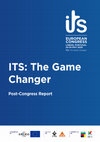
The 15th ITS European Congress – Post-Congress Report, 2023
The Congress’s principal theme “ITS: The Game Changer” was chosen to illustrate the powerful role... more The Congress’s principal theme “ITS: The Game Changer” was chosen to illustrate the powerful role Intelligent Transport Systems, digitalisation, and cooperative, connected and automated mobility can play in addressing the key challenges in the mobility and transport sectors. Deployment of ITS can take us further down the road to a mobility world that is accessible, equitable, affordable, efficient, has zero fatalities, has zero emissions, is resilient when stressed, is seamless across Continents and is sustainable. How to achieve these benefits was presented in policy discussions, technical and research paper sessions, demonstrations, technical tours, the Congress Exhibition and the Smart Mobility Summit of Cities and Regions. Part 1 of this Report summarises all the Congress proceedings. The second part paints a picture of discussions at the Plenary Sessions. The third part focuses mostly on the Technical & Scientific papers and the Special Interest Sessions. The final part summarises the proceedings at the Smart Mobility Summit of Cities and Regions.
Intelligent Transport, 2023
Carol Schweiger, Intelligent Transport Advisory Board Member and President of Schweiger Consultin... more Carol Schweiger, Intelligent Transport Advisory Board Member and President of Schweiger Consulting LLC, shares her expertise and perspectives on the challenges and opportunities within the transportation industry as it embraces technology-enabled mobility, as well as the key factors driving its transformation.
Intelligent Transport, Volume 7, Issue 2, 2023
Intelligent Transport Advisory Board member, Carol Schweiger, discusses the benefits and challeng... more Intelligent Transport Advisory Board member, Carol Schweiger, discusses the benefits and challenges of implementing new payment technologies in public transport systems, such as mobile fare payment and contactless payment readers, while highlighting the importance of ensuring that these technologies are user-friendly and accessible to all passengers, including those who may not have access to a smartphone or bank account. In addition, she weighs both the positives and negatives of the industry becoming fare-free, and considers what the future may look like in this space.
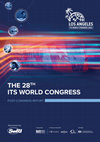
The 28th ITS World Congress Post-Congress Report, 2022
The Congress’s principal Theme “Transformation through Transportation” was chosen to illustrate t... more The Congress’s principal Theme “Transformation through Transportation” was chosen to illustrate the radical role Intelligent Transport Systems, digitalisation, and cooperative, connected and automated mobility can play in addressing the key technical and social challenges in the mobility and transport sectors. Deployment of ITS can take us further down the road to a mobility world that is accessible, equitable, affordable, has zero fatalities, has zero emissions, is resilient when stressed, is seamless across Continents and is sustainable. How to achieve these benefits was presented in policy discussions, technical and research paper sessions, discussion forums, demonstrations, technical tours and the Congress Exhibition. The headline theme was addressed by a wide range of different types of sessions, over 150 in total – Plenary, Special Interest, Technical, Scientific – as well as specialised Workshops and Forums. Part 1 of this Report summarises the Congress proceedings. The second part paints a picture of proceedings at the Plenary Sessions. The third part focuses on the Technical & Scientific papers and the Special Interest Sessions but also covers Workshops and the International and Regional Forums. The final part summarises the proceedings at the High Level Policy Round Table.
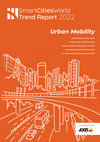
Smart Cities World Trend Report, 2022
Moving people and goods from A to B is – and always has been – one of the most significant challe... more Moving people and goods from A to B is – and always has been – one of the most significant challenges that cities face. The shape of our cities is so informed by our roads that if we were to begin again, the urban environment would be scarcely recognisable.
In this report, SmartCitiesWorld is breaking down the challenge facing cities around mobility to assess the trends that are moving urban transport development forwards, considering the travel experience, the need for more sustainable services and business models, and the future of connectivity and autonomy across urban transport networks.
Against a backdrop of pandemic recovery where traffic levels bounced back to normal but left shared modes of transport still recovering ridership, sustainability is key. In this report we focus on electrification as a basis for progressing the sustainability agenda, assessing the progress that cities and their transportation authorities have made to date.
Electrification is only part of this story, however; there’s also assessment of the state of integrated shared mobility services, the idea that they can provide genuine alternatives to personally-owned car journeys, and the impact that could have on citizens’ behavioural change to reduce congestion and improve mobility. As part of this shift, mobility users need to feel that they’re safe and that they can rely on new modes of travel; connected and autonomous mobility is a crucial part of that equation for the future, and the report focuses on some of the groundwork that’s being laid to ensure a more connected and autonomous future can be achieved.
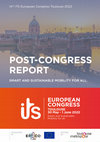
The Congress’s principal theme “Smart and Sustainable Mobility for all” was chosen to illustrate ... more The Congress’s principal theme “Smart and Sustainable Mobility for all” was chosen to illustrate the radical role Intelligent Transport Systems, digitalisation, and cooperative, connected and automated mobility can play in addressing the key challenges in the mobility and transport sectors. Deployment of ITS can take us further down the road to a mobility world that is accessible, equitable, affordable, has zero fatalities, has zero emissions, is resilient when stressed, is seamless across continents and is sustainable. How to achieve these benefits was presented in policy discussions, technical and research paper sessions, demonstrations, technical tours and the Congress Exhibition. The Congress was organised around five key topics: Services for citizens, Innovative solutions, Green & sustainable mobility, Large-scale trials to deployment and Cities as Logistics hubs. Part 1 of this Report summarises the Congress proceedings. The second part paints a picture of proceedings at the Plenary Executive Sessions. The third part focuses mostly on the Technical & Scientific papers and the Special Interest Sessions. The final part summarises the proceedings at the ITS Summit.
Intelligent transport: Reporting from the cutting-edge of urban transport technology, 2020
The report documents the current state of the practice in the use of open data for improved trans... more The report documents the current state of the practice in the use of open data for improved transit planning, service quality, and customer information; the implications of open data and open documentation policies; and the impact of open data on transit agencies, and the public and private sectors. It focuses on successful practices in open transit data policies, use, protocols, and licensing. This synthesis is intended for transit agencies, the public, and the private sector. A literature review and detailed survey responses from 67 of 67 agencies surveyed around the world, including Canada and 14 European countries, a response rate of 100%, are provided. Also, four case examples offer more detailed information from agencies and organizations that have significant experience with providing open data.
Journal of Public Transportation, 2018
This report documents the System Requirements and Architecture for the Phase I implementation of ... more This report documents the System Requirements and Architecture for the Phase I implementation of the Integrated Dynamic Transit Operations (IDTO) Prototype bundle within the Dynamic Mobility Applications (DMA) portion of the Connected Vehicle Program. It builds off of the previous system requirements report and adds site-specific requirements.
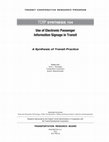
The nation's growth and the need to meet mobility, environmental, and energy objectives place dem... more The nation's growth and the need to meet mobility, environmental, and energy objectives place demands on public transit systems. Current systems, some of which are old and in need of upgrading, must expand service area, increase service frequency, and improve efficiency to serve these demands. Research is necessary to solve operating problems, to adapt appropriate new technologies from other industries, and to introduce innovations into the transit industry. The Transit Cooperative Research Program (TCRP) serves as one of the principal means by which the transit industry can develop innovative near-term solutions to meet demands placed on it. The need for TCRP was originally identified in TRB Special Report 213-Research for Public Transit: New Directions, published in 1987 and based on a study sponsored by the Federal Transit Administration (FTA). A report by the American Public Transportation Association (APTA), Transportation 2000, also recognized the need for local, problem-solving research. TCRP, modeled after the longstanding and successful National Cooperative Highway Research Program, undertakes research and other technical activities in response to the needs of transit service providers. The scope of TCRP includes a variety of transit research fields including planning, service configuration, equipment, facilities, operations, human resources, maintenance, policy, and administrative practices. TCRP was established under FTA sponsorship in July 1992. Proposed by the U.S. Department of Transportation, TCRP was authorized as part of the Intermodal Surface Transportation Efficiency Act of 1991 (ISTEA). On May 13, 1992, a memorandum agreement outlining TCRP operating procedures was executed by the three cooperating organizations: FTA, the National Academy of Sciences, acting through the Transportation Research Board (TRB); and the Transit Development Corporation, Inc. (TDC), a nonprofit educational and research organization established by APTA. TDC is responsible for forming the independent governing board, designated as the TCRP Oversight and Project Selection (TOPS) Committee. Research problem statements for TCRP are solicited periodically but may be submitted to TRB by anyone at any time. It is the responsibility of the TOPS Committee to formulate the research program by identifying the highest priority projects. As part of the evaluation, the TOPS Committee defines funding levels and expected products. Once selected, each project is assigned to an expert panel, appointed by TRB. The panels prepare project statements (requests for proposals), select contractors, and provide technical guidance and counsel throughout the life of the project. The process for developing research problem statements and selecting research agencies has been used by TRB in managing cooperative research programs since 1962. As in other TRB activities, TCRP project panels serve voluntarily without compensation. Because research cannot have the desired impact if products fail to reach the intended audience, special emphasis is placed on disseminating TCRP results to the intended end users of the research: transit agencies, service providers, and suppliers. TRB provides a series of research reports, syntheses of transit practice, and other supporting material developed by TCRP research. APTA will arrange for workshops, training aids, field visits, and other activities to ensure that results are implemented by urban and rural transit industry practitioners. The TCRP provides a forum where transit agencies can cooperatively address common operational problems. The TCRP results support and complement other ongoing transit research and training programs.
Intelligent Transport, 2022
This article shares thoughts on what the future looks like for technology-enabled mobility, and h... more This article shares thoughts on what the future looks like for technology-enabled mobility, and has identified five key strategies that will become significant in this field throughout the remainder of 2022 – with a particular focus on developments within MaaS.

This document serves as the Final Report specific to the Integrated Dynamic Transit Operations (I... more This document serves as the Final Report specific to the Integrated Dynamic Transit Operations (IDTO) Prototype Development and Deployment Project, hereafter referred to as IDTO Prototype Deployment or IDTO PD project. This project was performed under contract to the U.S. Department of Transportation (U.S. DOT) Intelligent Transportation Systems (ITS) Joint Program Office (JPO) in cooperation with the Federal Transit Administration (FTA). This final report provides a summary of the activities performed in conducting the IDTO PD project and documents the findings, lessons learned, and future considerations generated as an outcome of this work. As a prototype, IDTO was successful. It proved to be beneficial to the traveler, as throughout the demonstration period, users returned to use the application for trip planning/informational searches, and of those, over 25% took the action to monitor the trip and enable monitoring of transfers by the agencies to hold to allow for successful tra...

Intelligent Transportation Systems (ITS) and subsystems deployed by public transport agencies aut... more Intelligent Transportation Systems (ITS) and subsystems deployed by public transport agencies automatically generate and archive an enormous amount of information-rich data, which is otherwise costly to collect (e.g., operational information from the field, vehicle component health status and detailed data on ridership and revenue). The archived ITS data from various public transport ITS systems can be combined to create analytics toolboxes and interactive reports for stakeholders from various business units within a public transport organization. These toolboxes and reports can assist agencies in effective strategic planning and decision making processes which may lead to improved field operations and cost savings in the future. However, agencies have not always been able to utilize public transport ITS data to its fullest potential for a variety of reasons, several of which are discussed in this paper. The paper describes an effective 4-D (demand, dimension, data and delivery) app...

Starting in the early 2000s, many transit agencies in the US began to offer static information on... more Starting in the early 2000s, many transit agencies in the US began to offer static information on mobile devices, including timetables, service alerts and trip planning. At that time, there were a limited number of mobile devices on the market, meaning that some agencies could develop simple applications for these devices in-house without significant expenditures. For example, in the late 1990s and early 2000s, Bay Area Rapid Transit (BART) in the San Francisco Bay area developed its own applications for the Palm operating system (OS). However, since that time, there has been an explosion of mobile devices on the market, making it virtually impossible for agencies to keep current on the types of devices and their specific requirements, and be able to develop, manage and maintain mobile applications for these devices. This coupled with the fact that agencies can now provide more types of customer information caused agencies to look outside their organizations for third parties to ass...
Uploads
Papers by Carol Schweiger
In this report, SmartCitiesWorld is breaking down the challenge facing cities around mobility to assess the trends that are moving urban transport development forwards, considering the travel experience, the need for more sustainable services and business models, and the future of connectivity and autonomy across urban transport networks.
Against a backdrop of pandemic recovery where traffic levels bounced back to normal but left shared modes of transport still recovering ridership, sustainability is key. In this report we focus on electrification as a basis for progressing the sustainability agenda, assessing the progress that cities and their transportation authorities have made to date.
Electrification is only part of this story, however; there’s also assessment of the state of integrated shared mobility services, the idea that they can provide genuine alternatives to personally-owned car journeys, and the impact that could have on citizens’ behavioural change to reduce congestion and improve mobility. As part of this shift, mobility users need to feel that they’re safe and that they can rely on new modes of travel; connected and autonomous mobility is a crucial part of that equation for the future, and the report focuses on some of the groundwork that’s being laid to ensure a more connected and autonomous future can be achieved.
In this report, SmartCitiesWorld is breaking down the challenge facing cities around mobility to assess the trends that are moving urban transport development forwards, considering the travel experience, the need for more sustainable services and business models, and the future of connectivity and autonomy across urban transport networks.
Against a backdrop of pandemic recovery where traffic levels bounced back to normal but left shared modes of transport still recovering ridership, sustainability is key. In this report we focus on electrification as a basis for progressing the sustainability agenda, assessing the progress that cities and their transportation authorities have made to date.
Electrification is only part of this story, however; there’s also assessment of the state of integrated shared mobility services, the idea that they can provide genuine alternatives to personally-owned car journeys, and the impact that could have on citizens’ behavioural change to reduce congestion and improve mobility. As part of this shift, mobility users need to feel that they’re safe and that they can rely on new modes of travel; connected and autonomous mobility is a crucial part of that equation for the future, and the report focuses on some of the groundwork that’s being laid to ensure a more connected and autonomous future can be achieved.